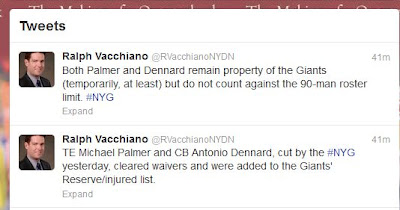• I wrote abut this subject back in February on Bigblueinteractive.com (see the link below).
"Minimum Salary Floor explanation for the salary cap" | Optimus-NY : 2/20/2013 12:46 pm
•Here's an excellent article discussing the subject from overthecap.com:
"Minimum Cash Spending: Does It Mean Anything?" by Jason Fitzgerlad from overthecap.com | February 17, 2013
*****
• There used to be a salary cap floor in the old CBA that has since been changed in the new CBA.
• Teams in the old system found ways around it.
• Teams used to have to spend a certain percentage of the salary cap each year (I think that the number was 84% in 2006).
• In order to get around this, teams used to use incentives during the
course of the season, which were termed “likely to be earned”, which in
turn were added the salary cap total. This accomplished two things.
1.) One thing was that certain teams used to use these incentives from
previous years in order to carry over cap space over to the next year
while reaching the minimum threshold for the salary cap in a given year
(e.g., the Eagles and the Jets).
2.) Another thing that certain other cheapskate teams used to do (e.g.,
the Bengals), in order to avoid paying players, while remaining cap
compliant, was to give an unreachable bonus to a player that counted
towards the salary cap for that year.
• With the new CBA, this is no longer the case.
• Teams now have cash spending limits instead now, so as to keep teams from doing what the Bengals did.
• As a result of the new CBA, there is a salary floor, not a cap floor.
• Most people, including myself, misunderstood this initially.
• This DOES NOT mean that teams have to spend X amount of dollars—specifically 89% of their cap—this coming 2013 season.
•
Here is what it does mean: what is happening now with this rule is
that teams don’t have to “blow their wad” so to speak all in one year in
2013 to spend the requisite money to reach the cash spending salary
floor.
• The NFL has decided to split these cash spending limits into 4-year periods.
• This is done over a 4-year period, or “bucket”—2013 to 2016 is the
cycle, or “bucket”, that is being started now in the league.
• For example, teams can spend below the salary cap this year, but still make it up in cash payments in 2014, 2015, or 2016.
• Teams need to meet 89% of the cap during this 4-year cycle, or
“bucket”—it doesn’t matter what year or years they spend this money in,
as long as they spend it by the end of the cycle, or “bucket”, in 2016.
• Bonuses count differently in this instance: rather than counting
towards the cap, they simply count for a given year (e.g., A bonus of
$15 million dollars signed over 3 years will count as $5 million in Cap
dollars, but will count in one year as $15 million in actual cash
spending—basically bonus payments count in one year).
• Teams can reach the minimum numbers by signing a couple of high priced
players per year with large bonus money—be they their own, or from
other clubs.
• This was a win for the NFLPA, in a CBA that they otherwise caved in to towards the owners.
• If teams don’t meet the salary floor over a 4-year cycle, or “bucket”,
the penalty will not be anything that affects teams in the cap.
• What will happen is that if a team fails to meet the cash spending
floor, they’ll simply have to pay out the remaining sum (e.g., $30
million) to the players who played for the team over that 4-year
span—being evenly distributed.
• This is advantageous because under the old system teams used to be able to horde this cash money that they saved.
• Under the new CBA this is not the case: teams can’t keep that cash money, anyway that you slice it. It MUST go to the players.
• In summation, teams like the Bengals, Colts, and Browns DON’T have to
spend the money this year to reach the salary floor linked to cash
spending.
• These teams don’t have to spend a dime this year, but at some point
before 2016 they will have to make moves to meet that cash spending
minimum—it’s not a set year-by-year number that must be strictly adhered
to.
*****
•In a future post, I will discuss the Giants' situation as it stands now.
•I'll demonstrate how the Giants' signing of their 2013 rookie draft class will put them ahead of the pace that they need to be on with regard to the cap spending floor.






